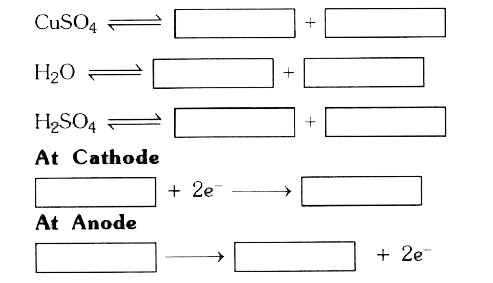In a 500mL of 0.5MCuSO4 solution, during electrolysis 1.5×1023 electron were passed using copper electrodes. Assume the volume of solution remains unchanged during electrolysis. Which of the following statements is/ are correect?
a. At the end of electrolysis, the concentration of the solution is 0.5M.
b.7.9g of Cu is deposited on the cathode.
c.4g of Cu is dissolved from the anode.
d.7.9g of Cu ions are discharged.
The correct Answer is:a,b,d
To solve the problem, we need to analyze the electrolysis of a 500 mL solution of 0.5 M CuSO₄ and the effect of passing 1.5×1023 electrons through it. We will also evaluate the correctness of the given statements.
1. Determine the Initial Conditions:
- Volume of CuSO₄ solution = 500 mL = 0.5 L
- Concentration of CuSO₄ = 0.5 M
- Moles of Cu²⁺ in the solution:
Moles of Cu2+=Concentration×Volume=0.5mol/L×0.5L=0.25mol
2. Calculate the Number of Moles of Electrons Passed:
- The number of electrons passed = 1.5×1023
- Using Avogadro's number (6.022×1023 electrons/mole), we can find the moles of electrons:
Moles of electrons=1.5×10236.022×1023≈0.249mol
3. Determine the Amount of Copper Deposited:
- The reduction of Cu²⁺ to Cu requires 2 moles of electrons to deposit 1 mole of Cu. Therefore, the moles of Cu deposited can be calculated as:
Moles of Cu deposited=Moles of electrons2=0.2492≈0.1245mol
- Now, calculate the mass of Cu deposited using the molar mass of Cu (63.5 g/mol):
Mass of Cu deposited=0.1245mol×63.5g/mol≈7.9g
4. Evaluate the Changes in Concentration:
- Since the volume of the solution remains unchanged and the amount of Cu²⁺ ions reduced is equal to the amount of Cu²⁺ ions oxidized (due to the copper electrodes), the concentration of Cu²⁺ ions in the solution remains the same at 0.5 M.
5. Analyze Each Statement:
- Statement a: At the end of electrolysis, the concentration of the solution is 0.5 M. (Correct)
- Statement b: 7.9 g of Cu is deposited on the cathode. (Correct)
- Statement c: 4 g of Cu is dissolved from the anode. (Incorrect) - The amount of Cu dissolved from the anode is equal to the amount deposited at the cathode, which is 7.9 g.
- Statement d: 7.9 g of Cu ions are discharged. (Correct) - This is the same amount that was deposited.
Conclusion:
The correct statements are a, b, and d.
- Volume of CuSO₄ solution = 500 mL = 0.5 L
- Concentration of CuSO₄ = 0.5 M
- Moles of Cu²⁺ in the solution:
Moles of Cu2+=Concentration×Volume=0.5mol/L×0.5L=0.25mol
- The number of electrons passed = 1.5×1023
- Using Avogadro's number (6.022×1023 electrons/mole), we can find the moles of electrons:
Moles of electrons=1.5×10236.022×1023≈0.249mol
- The reduction of Cu²⁺ to Cu requires 2 moles of electrons to deposit 1 mole of Cu. Therefore, the moles of Cu deposited can be calculated as:
Moles of Cu deposited=Moles of electrons2=0.2492≈0.1245mol
- Now, calculate the mass of Cu deposited using the molar mass of Cu (63.5 g/mol):
Mass of Cu deposited=0.1245mol×63.5g/mol≈7.9g
- Since the volume of the solution remains unchanged and the amount of Cu²⁺ ions reduced is equal to the amount of Cu²⁺ ions oxidized (due to the copper electrodes), the concentration of Cu²⁺ ions in the solution remains the same at 0.5 M.
- Statement a: At the end of electrolysis, the concentration of the solution is 0.5 M. (Correct)
- Statement b: 7.9 g of Cu is deposited on the cathode. (Correct)
- Statement c: 4 g of Cu is dissolved from the anode. (Incorrect) - The amount of Cu dissolved from the anode is equal to the amount deposited at the cathode, which is 7.9 g.
- Statement d: 7.9 g of Cu ions are discharged. (Correct) - This is the same amount that was deposited.
The correct statements are a, b, and d.
Topper's Solved these Questions
- ELECTROCHEMISTRYBOOK - CENGAGE CHEMISTRY ENGLISHCHAPTER - ELECTROCHEMISTRYEXERCISE - Solved Examples (Electrochemical Cell)
36 Videos
- ELECTROCHEMISTRYBOOK - CENGAGE CHEMISTRY ENGLISHCHAPTER - ELECTROCHEMISTRYEXERCISE - Solved Examples(Electrolysis And Electrolytic Cells)
12 Videos
- D AND F BLOCK ELEMENTSBOOK - CENGAGE CHEMISTRY ENGLISHCHAPTER - D AND F BLOCK ELEMENTSEXERCISE - Archives Subjective
29 Videos
- GENERAL PRINCIPLES AND PROCESS OF ISOLATION OF ELEMENTSBOOK - CENGAGE CHEMISTRY ENGLISHCHAPTER - GENERAL PRINCIPLES AND PROCESS OF ISOLATION OF ELEMENTSEXERCISE - Archives (Subjective)
14 Videos
Similar Questions
A current of 2.68A is passed for 1.0 hour through an aqueous solution of CuSO4 using copper electrodes.
Which of the following statements is / are correct ?
View SolutionA current of 2.68A is passed for 1.0 hour through an aqueous solution of CuSO4 using copper electrodes.
Which of the following statements is / are correct ?
View Solution1.0 L of 0.1 M aqueous solution of KCI is electrolysed A current of 96.50 mA is passed through the solutoin for 10 hour which is /are correct ? (assume volume of soluto remains constant during electrolysis)
View Solution1L of 1MCuSO4 solution is electrolyzed using Pt cathode and Cu anode. After passing 2F of electricity, the [Cu2+] will be
View SolutionDuring electrolysis of an aqueous solution of CuSO4 using copper electrodes, if 2.5g of Cu is deposited at cathode, then at anode
View SolutionFor the electrolysis of CuSO4 solution which is /are correct ?
View SolutionDuring the electrolysis of molten NaCl solution, 230 g of sodium metal is deposited on the cathode, then how many moles of chlorine will be obtained at anode?
View SolutionDuring electrolysis of aqueous solution of a salt, pH in the space near one of the electrode is increased . which of the following salt solution was electrolysed ?
View SolutionComplete the following table with respect to electrolysis of acidulated copper sulphate solution using copper electrode :

View SolutionOxygen and hydrogen gas are produced at the anode and cathode during the electrolysis of fairly concentration aqueous solution of :
View Solution
